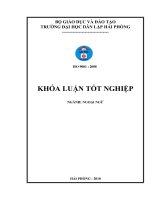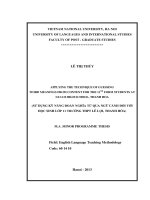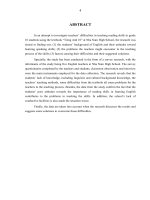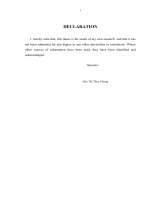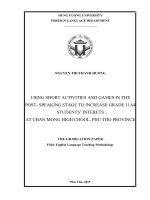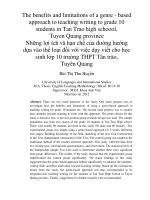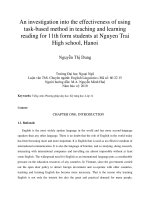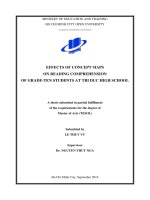How to teach grammar communicatively for grade 10 students at Thanh Ba high school Phu Tho province
Bạn đang xem bản rút gọn của tài liệu. Xem và tải ngay bản đầy đủ của tài liệu tại đây (518.66 KB, 81 trang )
1
ACKNOWLEDGEMENTS
This thesis would not have been possible without the help and
support of many individuals. I would especially like to thank the following
people.
Ms. Ngo Thi Thanh Huyen, who has guided me to do this thesis.
Without her expert guidance, insightful comments and constructive
feedback, my thesis would have still been far from completed.
I would be grateful allthe lecturers who have been teaching in
Foreign Language Department, Hung Vuong University, contributed to
the success of the course.
I would also like to thank all the teachers and the students at Thanh
Ba High School in Phu Tho, who willingly participated in the study. I thank
them for their time, patience and willingness in completing the
questionnaires, answering the questions and sharing their classrooms
with me.
Last but not less importantly, I owe my parents and friends whose
unconditional love, understanding, encouragement, and support are
valuable during my whole study.
Phu Tho, April 2016
1
2
LIST OF ABBREVIATIONS
STT
TTT
CLT
TGC method
S1 ->40
Q1->5
Student’s talking time
Teacher’s talking time
Communicative Language Teaching
Teaching grammar communicatively method
Student 1 ->40
Question 1->5
2
3
LIST OF FINGURES AND TABLES
3
4
TABLE OF CONTENT
4
5
PART A: INTRODUCTION
1. Rationale
English is presently considered as an international language which
is used widely in the world and in almost all fields of the study. In the past
decades, it has been proved to be the most valuable means for people to
acquire knowledge, to entertain them and to communicate with the
others. Therefore, the teaching and learning of English has become very
popular and necessary. However, one aspect of teaching English is
teaching grammar which has been considered as a challenge for many
Vietnamese teachers of English at school.
Therefore, this study was inspired by both the subjective and
objective reasons. Subjectively, doing a study on methodology, especially
on teaching grammar, is a very useful preparation for my future job as a
teacher of English. Simultaneously, it is very practical for the teaching
practice as a trainee teacher at a high school in Phu Tho. Moreover, I have
chosen this subject due to the awareness of the importance of English
grammar. Without learning it, students cannot communicate well, to put
it another way, the language they produce which is considered
ungrammatical and unacceptable. Hence, it is essential to teach grammar
effectively and appropriately at the very beginning stage.
The objective reason for choosing this topic comes from the current
situation of teaching grammar at high schools. In a grammar lesson at
high schools, most of the practices are done in the forms of writing and
the teacher seldom creates activities that may help students to put what
they have learnt into use. Therefore, although students have learnt
numerous grammar rules, words and sentence structures, they cannot
express themselves when they speak in English. It may surprise us that
many students cannot use English as a means of communication after
several years of learning it at school.
5
6
For these reasons, the researcher decided to conduct the research
on "How to teach grammar communicatively for grade 10 students at
Thanh Ba high school- Phu Tho province". Hopefully, it will make a
small contribution to the teaching and learning grammar at the high
school.
2. Research purposes
The study aims at raising the importance of grammar teaching.
Moreover, it is intended to find out major difficulties that students
encounter as well as their attitudes towards learning English grammar. In
addition, the prevalent teaching methods that are widely used to teach
English grammar at high schools in Phu Tho are studied on, and then
their advantages and disadvantages are drawn out. Moving on, in another
place, a variety of techniques and activities are suggested to achieve the
effectiveness in teaching grammar. In addition, how to use these
techniques and activities successfully is taken into consideration in the
application for students at Thanh Ba high school.
3. Research questions
The research will find the answers for the following questions:
1. What are the attitudes of the students toward teaching and
learning grammar communicatively?
2. How is the students’ grammar improved after the application of
the treatment?
3. What suggestions should be given to the students?
4. Methodology
4.1. Research procedure
Firstly, the definitions of some terms related to the grammar was
clarified by study theory
6
7
Secondly, the current situation of learning English grammar of the
students in class 10A and 10B at Thanh Ba high school were investigated,
then some suggested solutions are given.
Thirdly, the experiment was carried out with the treatment to teach
grammar for students effectively.
Fourthly, pretests and posttests was given to the students of the
two groups (control group and experimental one); then the result of the
two tests were compared to see whether there are any improvements in
the students’ grammar or not.
Finally, from the research findings, some suggestions were given.
4.2. Research methods
The theoretical background of the study is mainly based on the
book and documents written by a number of scholars on foreign language
teaching.
Within the aim of finding out the current situation and getting
some results after experiment in teaching and learning grammar in class
10A and 10B at Thanh Ba high school, this study adopts quantitative,
qualitative and experimental methods. To identify the problems, the
study has been carried out with the data collected from different
instruments:
- Pre- questionnaire: This questionnaire is for the students under this
research and aims to obtain understandings about students’ attitudes,
their motivation in grammar. Students will be given this questionnaire
before the treatment. The questionnaire consists of two parts:
+ Part I aims to explore the students’ attitudes toward teaching grammar
communicatively.
+ Part II aims to explore the students' participation in teaching grammar
communicatively.
7
8
- Post questionnaire: Post questionnaire was delivered to students after
teaching grammar communicatively. The post questionnaire aims to
measure the students’ attitudes and motivation after being given the
treatment to see if there is any increase of their motivation and
participation in grammar lesson in the class. Based on the findings from
this post questionnaire, together with the result of the post test, the
researcher can go to the necessary conclusions and give suggestions.
- Pretest and posttest: The pretest and posttest are a set of questions and
exercises.
The pretest helped ensure the compatibility in the students’ English
level to divide them into control group and experimental group.
Moreover, the pretest also provides the researcher with accurate
assessment on the students’ English grammar knowledge to make
comparison with their result of the posttest, so that researcher of the
study can go to necessary conclusions about the effects of teaching
grammar communicatively on the student's grammar competence. After
carrying out pretest, I used some treatments following:
•
I used pictures, situations, and examples for presenting
grammatical structures.
•
I used picturesfor checking students’ understanding of what
has been presented.
•
I used oral drills, written exercises at the practice stage.
After
applying
some
treatments
in
teaching
grammar
communicatively, the posttest administered among these students. The
result of the posttest compared with the one of the pretest to see any
changes and improvements in the students and give necessary
suggestions.
5. Significance of the study
8
9
Theoretical significance of the study: the study supplied the English
teachers with the understanding of language in term of types, advantages
when employing them. The study also suggested some ways to exploit
language focus successfully during all stages in teaching grammar.
Practical significance of the study: the study helped the teacher of
English teach grammar more effectively, which made language focus
lessons more communicative and meaningful.
6. Hypothesis
If the study "How to teach grammar communicatively for grade 10
students at Thanh Ba high school- Phu Tho" was successfully, this would
help students in class 10A improve their level of language focus.
7. Scope of the study
The research focus on some effective techniques and activities used
in grammar teaching for 40 students at grade 10A and 40 students at
grade 10B, Thanh Ba high school.
8. Design of the study
Part A: INTRODUCTION
1.1. Rationale.
1.2. Research purpose.
1.3. Research question.
1.4. Research methods.
1.5. Significance of the Study.
1.6. Hypothesis
1.7. Scope of the study.
1.8.Proposed schedules.
1.9. Design of the study.
Part B: MAJOR CONTENT
9
10
Chapter1: deals with the theoretical background that is relevant to the
purpose of the study: grammar, different views on English grammar
teaching.
Chapter2: Methodology
Chapter3: Data analysis and discussion
Part C: CONCLUSION
1
Main findings.
2
Implications.
3
Limitations and Suggestions for Further Research.
4. Conclusion.
10
11
PART B: DEVELOPMENT
CHAPTER 1: LITERATURE REVIEW
1.1. OVERVIEW OF GRAMMAR
1.1.1 Definition of Grammar
Grammar seems to be a very familiar term in language teaching and
learning. However, it is difficult to define exactly what grammar is. Up to
now, many attempts have been made for this.
The Oxford Advanced Learner’s Dictionary defines that “ Grammar
is the rules in a language for changing the forms of words ang combining
them into sentences”. For example, the word “went” is the past form of the
word “go” and that word combines with such words as “I, to, visit, my
grandparents, yesterday” to make a sentence: “I went to visit my
grandparents yesterday”.
Harmer (1987) gave another definition of grammar: “Grammar is
the way in which words change themselves and group together to make
sentences. The grammar of a language is what happens to words when
they become plural or negative, or what word order is used when we
make questions or join two clauses to make one sentence” (p.1). It can be
seen that the ideas of two definitions are much similar in that they both
see grammar as a system consisting of the change of word forms and the
combination of words into sentences.
Ur (1988) has given a broader definition to grammar, which is clear
and easy to understand: Grammar may be roughly defined as the way a
language manipulates and combines words (or bits of words) in order to
form longer units of meaning. For example, in English, the present form of
the verb be in the third person has two distinct forms, one (is) being used
with a singular subject and the other (are) with a plural; and if the plural
are is combined with a singular subject, the result is usually unacceptable
or “ungrammatical”. Thus, a sentence like: This is a book is grammatical,
11
12
whereas This are a book is not. There is a set of rules, which govern how
units of meaning may be constructed in any language”.
In short, whatever grammar may be defined, it involves the set of
rules that defines how words or words are combined together to make up
meaningful units of language. Moreover, it cannot be denied that students
know how to put the isolated words into meaningful sentences to serve
the communicative purposes.
1.1.2 Grammatical Structures
Ur (1996) has shown that “A specific instance of grammar is usually
called a structure. Examples or structures would be the past tense, noun
plural, the comparisons of adjectives or adverbs, relative pronouns and so
on” (p.75). However, when talking about “knowing a language”, we do not
only mean “knowing the structure of a language”. This can also mean one
of the following things.
First, it may refer to the unconscious ability to use the structure of a
language to convey meaning. The user of the language does not have to
recall the structure rules to create sentences. The mental processes he
uses to produce correct sentences are hidden. This stage of knowledge is
called “unconscious knowledge”.
Second, it may refer to the information that has been deliberately
acquired through studying structural descriptions. Non- native learners
of the language can know the structure of a language mainly through
studying. Then apart from understanding the rules, in meaningful
sentences. Therefore, Ur (1988) pointed out that: “When we teach anyone
of these types of structures, we are or should be clear getting our
students quite a large number of different, though related, bits of
knowledge and skills: how to recognize the examples of structure when
spoken and written form, how to understand its meaning in context, and
produce meaningful sentences using it themselves”.
12
13
13
14
1.1.3 Grammatical meaning
Ur (1996) shows that grammar does not nobly affect how units of
language are combined in order to "look right"; it also affects their
meaning. The teaching of grammatical meaning tends, unfortunately, to
be neglected in many textbooks in favor of an emphasis on accuracy of
form; but it is no good knowing how to perceive or construct a new tense
of a verb if teachers do not know exactly what difference it makes to
meaning when it is used. It is very the meanings of the structures, which
create the difficulties for foreign learners mentioned above. The meaning
of grammatical structures may be quite difficult to reach. It is simple to
explain that the addition of a plural -s to the noun in English and Fresh
indicates that teachers are taking about more than one term, and there
are parallels in other language. Nevertheless, how would teacher explain
to the foreigners when to use the present perfect (i have gone, for
example) in English, and when the past simple (i went)? If all teachers are
grammarians or experienced English language teachers, they may have
the answer at their fingertips, but most English speakers who have not
previously studied this question will have to stop and think, and may find
it difficult to answer.
In this research's opinion, the learners can sometimes translate
words by words from English into Vietnamese. However, it is very
important to translate into meaningful sentences in Vietnamese.
Therefore, the learners must note the way to translate words from
English into Vietnamese, sometimes it is translated from the first word to
the final words as the Vietnamese, sometimes it is against.
1.1.4 The importance of Grammar
Teaching grammar has been a longstanding tradition in teaching a
foreign language. In recent years, the role of grammar in language
teaching ang learning has received different interpretations. Traditional
14
15
method like the grammar translation one stressed the need to master
grammar as the centerpiece in learning a foreign language whereas some
expressed different views against the teaching grammar. “The study of
grammar is neither necessary nor sufficient for learning a language”
(Brumfit and Johnson, 1979). Therefore, there has been a great
controversy relating to the raised question: “Whether should we teach
grammar or not? Do we have to have grammar exercises? Isn’t it better
for students to absorb the rules intuitively through communicative
activities than to be taught through special exercises?” (Ur, 1988). Some
linguists have given their answer to these big questions.
According to Richards, Platt, and Weber in Nunan (2005:2)
grammar is a description of a language and the way in which units such
as words and phrases are combined to produce sentences in the
language. From this definition, it seems that grammar plays an
importance role in combining units of language to form sentences. The
sentences are acceptable or grammatically if they follow the rules of
grammar. Since a communicative purpose and function of language and
reflected in grammar, it is a must the language students to acquire good
grammar. It should be admitted, good mastery in grammar will enable
people easily to express information, feeling, and ideas in their thought to
others. In other words, it can be said that communication failure will
happen if people do not master the grammar because the purpose of
communication cannot be reached. From that statement, it is clear that
grammar is important to be mastered by the students in order to be able
to express their feelings, emotions, and to be able to use English
appropriately.
Ur (1988) stressed the importance of grammar in language
learning and teaching. He stated “knowledge – implicit or explicit – of
grammatical rules is essential for the mastery of a language: you cannot
15
16
use words unless you know how they should be put together”. However,
he also claims “the learning of grammar should be seen in the long term
as a whole, not as an end in itself” (1988).
Harmer (1987) also admitted that: “There is now a general feeling
that students do need lo learn how to perform the functions of language,
but they need a grammatical base as well. Modern courses often teach a
grammatical structure and then get students to use it as part of a
functional conversation”.
In conclusion, there still exist controversies about the role of
grammar in language teaching and learning. However, it can be seen that
the above – mentioned linguists share the same view in valuing the
crucial role of grammar in language learning and teaching. However, they
assert that the sole mastery of grammar is not the goal of language
learning. The students’ ultimate goal in learning grammar is to use it to
perform communicative functions accurately, effectively and successfully.
Indeed, grammar offers students one of the most effective means of
extending students’ knowledge of language items in which they can use to
communicate in real life and to understand what is said written in
English.
1.2 THE EFFECTS OF GRAMMAR PRACTICE ACTIVITIES
Similar to other activities, grammar practice activities have both
advantages and disadvantages. Beside some disadvantages of time or
students' awareness, grammar practice activities show some its
advantages and effect.
1.2.1 Good points
Grammar practice activities can help students improve the ability
of creation because they must make brainstorm to do the tasks.
16
17
These activities can also help students be clearer about structures
and their use. Therefore, they can say out various sentences based on the
form. In addition, the students can remember structure better.
Otherwise, these activities make students be active in activities and
help students be the centre in the class.
Using grammar practice activities is one of teaching methods
contributing in making the variety of improving teaching and learning
methodology effectively. Teacher can help students produce structures
correctly on their own by some grammar practice activities.
These grammar practice activities attract students to practice
producing structures by themselves basing on available forms. This is
very useful for students to remember structures carefully.
1.2.2 The effect of the Method
Ur (1996) is especially interested in the effect of this method of
helping students produce structures correctly on their own through
seven types of grammar practice activities from accuracy to fluency, they
are awareness, controlled drills, meaningful drills, guided, meaningful
practice, (structure- based) free sentence composition, (structure- based)
discourse composition, free discourse.
•
Type 1: Awareness
After the learners have introduced to the structure, they are given
opportunities to encounter it within some kind of discourse, and do a
task that focuses their attention on its form and/ or meaning.
•
Type 2: Controlled drills
Learners produce examples of the structure: these examples are,
however, predetermined by the teacher of textbook, and have to conform
to very clear, closed- ended cues.
•
Type 3: Meaningful drills
17
18
Again, the responses are very controlled, but the learners can make
a limited choice of vocabulary.
•
Type 4: Guided, meaningful practice
Learners form sentences of their own according to a set pattern,
but exactly what vocabulary the use is up to them.
•
Type 5: (structure- based) free sentence composition
Learners are provided with a visual or situational cue, and invited
to compose their own responses, they are directed to use the structure.
•
Type 6: (structure- based) discourse composition
Learners hold a discussion or write a passage according to giver
task, they are directed to use at least some examples of the structure
within the discourse.
•
Type 7: Free discourse
As in type six, but the learners are given no specific direction to use
the structure, however, the task situation is such that instances of it are
likely to appear.
1.3 DIFFERENT VIEWS ON GRAMMAR TEACHING
The past century has witnessed the appearance, the development
and the changes in methods of teaching foreign language. Naturally, each
method has its distinctive features. As a result, there are different
viewpoints on the teaching grammar of the target language.
1.3.1 Traditional Methods
1.3.1.1 The Grammar – Translation Method
The Grammar – Translation method was popular in foreign
language teaching from the 1840s to the 1940s. It was a dominant
method until the end of the twentieth century and in its modified forms,
it has continued to be used in some places nowadays. Grammar –
Translation is a way of studying a language that approaches the language
18
19
first through detailed analysis of its grammar rules, followed by the
application of this knowledge to the task of translating sentences and
texts into and out of the target language. Hence, it views language
learning as consisting of little more than memorizing rules and facts in
order to understand and manipulate the morphology and syntax of the
foreign language” (Richard and Rogers, 1986).
In this method, the teaching of grammar possesses the following
features:
• Grammar is taught deductively, that is in a typical grammar –
translation text, and the grammatical rules of the target language are
presented in the mother tongue and illustrated through translation
activities.
• Teacher’s role is to explain grammar rules and the meaning of the
words in the students’ native language.
• Students’ role is to pay close attention to teacher’s explanations
and corrections, memorize rules and vocabulary lists, and carefully do the
translation tasks.
The strong points of this method can be drawn from its above
features. First, students taught in this method are usually good at
grammar because of their great attention to it. Second, this method does
not require much effort from the teacher as he often overuses the mother
tongue as the main means to explain the grammatical points. Third,
translation exercises can rule out the ambiguity or misunderstanding
between the students in learning a new grammatical structure as
everything is translated clearly into their mother tongue.
However, this method has some shortcomings, the biggest of which
is that students are considered to be passive recipients of the given
knowledge. They learn by absorbing the teacher’s explanation in the
mother tongue, memorizing grammar rules and vocabulary list. They do
19
20
not have many chances to think, learn and carry out meaningful
communicative activities in the target language.
Due to its weak points and inefficient outcome, this method is
rarely used in learning and leaching foreign language in schools in the
world nowadays. Even in our country, although grammar translation
method used to be popular for a long time, the use of this method in
schools has proved many drawbacks and hence needs to be changed.
1.3.1.2 The Direct Method
The direct method is a method of teaching that developed at the
turn of the 20th century. This method developed as a revolution against
the grammar – translation method. Therefore, grammar was also taught
in different ways. This method stresses that the second language learning
should be more like the fist language learning with a lot of oral
interactions and spontaneous responses. The direct method is
characterized, above all, by the use of the target language as a means of
instruction and communication in the language classroom, and by the
avoidance of the use of the first language” (H.Stern, 1983).
Then, it could be seen that the teaching of grammar in this method
also carries its distinctive features. While prioritizing oral skills, it rejects
explicit grammar teaching. The students are supposed to pick up the
grammar of the target language in much the same way as children do that
in their mother tongue, simply by being immersed in it. As a result, this
method has some advantages. First, it provides students more chances to
speak the target language and creates a good foreign language – learning
environment. It also enables students to think and the language easily.
Nevertheless, this method has to cope with many challenges. “...it
requires teachers who were native speakers or who had native like
20
21
fluency in the foreign language. It was largely dependent on the teachers’
skill, rather than on a text book and not all teachers were proficient
enough in foreign language to adhere to the principle of this method”
(Richard and Theodore, 1991, p.10). This method requires the teacher to
be very fluent in the target language and all the foreign language classes
to be small – sized. This does not prove practical and useful in the
financially poor situation, as it is difficult and costly to hire all native or
native like speaking teachers and to run small – sized classes in all
schools. In addition, as this method forces student to express himself too
soon in the target language, they can speak fast and fluently but not
accurately due to the lack of the systematic practice of the structures.
More importantly, as oral interaction and spontaneous reaction are given
prior stress, slow –minded students will be discouraged because they
often find it difficult to catch up with the fast pace of the learning process.
Being the contradiction to the grammar –translation method, this
has not been seen as a better one. The use of this method in the situation
of Vietnam schools could encounter such numerous difficulties as
students’ inability to perform the language accurately and school
financial matters.
1.3.1.3 The Audio –Lingual Method
The immergence of the audio –lingual method resulted from the
increased attentions given to foreign language teaching in the United
States at the end of the 1950s. Then Audiolingualism reached the period
of most widespread use in the 1960s and it was applied both to the
teaching of foreign languages in the United States and to the teaching of
English as a second language in many other places.
The teaching of grammar in this method has some features as
follows:
21
22
•
The use of dialogues as the chief means of presenting the
language
• Emphasis on dialogues as the chief means of presenting the
language, mimicry, memorization, and pattern drills
• The use of the language laboratory
(H.Stern, 1983, p.462)
The prevailing point of this method is that it gives good attention to
students’ pronunciation and promotes their successful responses, which
can better their ability to communicate. Moreover, much use of tapes,
language labs and visual aids can facilitate the learning process of the
students as this can add a lively and interesting atmosphere to foreign
language classes.
Nonetheless, this method also proves some drawbacks. First,
students vocabulary is simple and limited because most of the words are
learned in a dialogue context. Second, students are turned into a kind of
machine through repetitive drills, mimicry and memorization of set
phrases, which do not help to promote their creativity.
1.3.2 The Communicative Approach
At the time when the previous foreign language teaching method
all proved their drawbacks, Communicative Language Teaching (CLT) has
been put forth around the world as the “new” or “innovative” approach to
teach English as a second language. Teaching materials, course
descriptions, guidelines proclaim a goal or communicative competence.
According to Seidl (2005), language is more than simply a system
or rules; rather it is seen as a dynamic resource for the creation of
meaning. In terms of learning, it is generally accepted that we need to
distinguish between “learning what” and “knowing how”. To some extent,
that is to say, students do not simply learn the language structures and
grammar rules, rather they should take part in activities such as problem
22
23
solving, writing for a purpose, and discussion on topics of genuine
interest, ect. Students in communicative classrooms are seen as active
recipients of information provided by teachers or the textbooks. Teachers
are no longer viewed as the authority of the knowledge, playing a
dominant role. They are just in the roles of a facilitator, a participant, and
a counselor to create more fascinating experiences for the students. In
general, the CLT helps students learn a language through authentic and
meaningful communication, which involves a process of creative
construction, in order to achieve fluency.
In addition, Nunan (1991a: 279) offers five features to characterize
CLT:
•
An emphasis on learning to communicate through interaction in
the target language.
• The introduction of authentic texts into the learning situation.
• The provision of opportunities for learner to focus, not only on
the language but also on the learning process itself.
• An enhancement of the learner’s own personal experiences as
important elements to classroom learning.
• An attempt to link classroom language learning with language
activation outside the classroom.
From the above features, we can see that this approach promotes
and encourages students to communicate and interact in the target
language with the orders because its uttermost goal is to help them
achieve communicative competence. Moreover, this approach sees
authentic texts as a basic premise in teaching and learning language
aspects or skills. The students do not have to memorize all the
complicated grammar rules, rather they have chance to practice the
structures in meaningful situations. In addition, the students in this
approach are the center of the whole learning process. The teacher can
23
24
act as a facilitator, an organizer, a supervisor and can help their students
gain the knowledge in a more active and independent way.
Yet, inevitably, besides the strong points, CLT also has some
weaknesses. It is argued that CLT provides students with supportive
vocabulary for functional language use, but with little guidance about
how to handle vocabulary. According to Henner –Stanchina and Riley
(1978), CLT focuses on the learner –centered approach, while in some
accounts of CLT, students bring preconception of what teaching and
learning should be like. However, despite few weaknesses, CLTstill gains
its status as the most effective approach in language teaching nowadays.
A glance at the strong and weak points of each foreign language
teaching method and approach has brought about some judgments about
the efficiency and applicability of each method in schools. Using the
grammar –translation method can result in the students’ extremely poor
ability to communicate whereas the too early exposure to the target
language in the using. Similarly, the consequence of to much repetition in
the audio –lingual method cause the boredom in foreign language
teaching. The communicative approach has proved many strong points;
on striking example of which is that it helps students achieve intelligible
communication through meaningful communicative activities. As a result,
the prevailing strengths of the communicative approach have helped
itself achieve the status as the most efficient foreign language teaching
approach.
1.4 TEACHING GRAMMAR ACCORDING TO THE COMMUNICATIVE
METHOD
1.4.1 Requirements in a Grammar Lesson
Any teacher who teachers a grammatical item has to define his
objectives by asking himself what his students have to learn. According to
Hubbard (1989), there are three main things that students have to
24
25
acquire in a grammar lesson. First thing is the form of a grammatical
structure which is “the actual words (written) of sounds (spoken) used to
express something in the language, the form is often synonymous with
the structure” (1989, p.158). The second is the meaning of the structure.
It is “the conventional and literal meaning of a particular form” (1989,
p.159). The use of form may be described in terms of its function or
communicative purpose” (1989, p.160).
While the grammar translation method and some other structural
approach focus on the accuracy of the form, the communicative approach
has turned its attention to the use of the language in situation. Littlewood
(1981) claimed “... the goal of foreign language teaching is to extend the
range of communication situations in which the learners can perform
with focus on meaning without being hindered by the attention he must
pay to linguistic form” (p.89). Therefore, after a grammar lesson, students
achieve this; two main kinds of activities need to be carried out in a
grammar lesson. The first on is pre- communicative activities including
the presentation, then the controlled and guided practice. The second is
communicative activities which are considered as the free practice.
In brief, the requirement for a successful grammar lesson is that
after learning a certain grammatical structure, the students are able to
use it in real life communication.
1.4.2 The Stages of Grammar Teaching
The most common procedure for teaching grammar is as follow:
•
•
•
The presentation stage
The practice stage
The production stage (Free practice)
1.4.2.1 The presentation stage-Its features and aims
25

